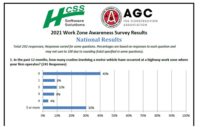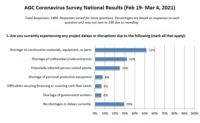Construction employment levels increased in May in nearly all of the metropolitan areas that the Associated General Contractors of America tracks and a separate survey by AGC and technology company HCSS found that highway work zone safety remains a problem for contractors, though the coronavirus pandemic has made it less severe.
Ken Simonson, chief economist for AGC, said that although construction nationwide lost nearly 1 million jobs in April, "As many states have begun to ease the restrictions that led to much of that job loss, construction employment has begun to bounce back in much of the country."
According to an AGC analysis released June 30 and based on federal employment data, the number of construction jobs increased in 329 of 358 metro areas between April and May.
The Seattle-Bellevue-Everett, Wash., area showed the largest increase in construction jobs in May—28,600, a 44% increase, Simonson noted.
New York City, which recently allowed construction to resume, ranked second, with a gain of 25,000, or 31%.
Pittsburgh recorded the largest percentage jump, 60%, based on an increase of 22,000 jobs.
Results of the AGC-HCSS annual work zone safety survey, also released on June 30, showed that 68% of responding contractors reported at least one moving-vehicle crash in work zones in 2019, and 33% reported five or more such accidents.
The survey also showed that 5% of respondents said a construction worker had died in a work-zone crash in 2019, and 15% reported a driver or passenger fatality in a work-zone accident.
Another finding was that 17% of the crashes resulted in injuries to at least one worker, and 44% of contractors said there had been injuries to drivers or passengers in at least one crash.
The survey was based on responses from 200 AGC-member contractors that work on road and highway projects.
"We do have a problem of people speeding and being dangerous in our work zones,” said Jason Koss, industry relations director for the Constructors Association of Western Pennsylvania. The association is AGC's chapter for Pittsburgh-area highway contractors. “Speeding and distracted driving do occur,” he added.
The COVID-19 pandemic appears indirectly to have improved work zone safety, survey results indicated, as 60% of respondents said work zones were safer because fewer vehicles were on the road.
But 20% of companies rated highways and roads less safe, since having fewer drivers on highways means that motorists were more likely to speed or take other chances, possibly because they believed they were alone on the road.
In addition, 24% of respondents said a greater police presence would improve safety. A Pennsylvania pilot program to use mobile speed cameras to combat speeders has resulted in 30,000 warnings or tickets for violations since March.
Moreover, 17% of respondents said they favored increased use of positive barriers, commonly known as jersey barriers, to improve safety.
Asked about the reasons for increased accidents, 81% of responding companies cited "cellular phones as a distraction."
Only 7% of contractors pointed to increases in traffic, while 12% identified speeding as the primary factor in higher accident totals.
"Contractors really have adapted to the coronavirus, based on what we hear from our 88 chapters," Simonson said.
He added that the study found procedures contractors have put in place are just as important for increased safety as lower traffic volumes in work zones.
Simonson said the safety-related actions resulted in "widening that buffer between traffic and construction" and enabled workers "to get off the project sooner when it comes to number of hours and days on the job."
He said, "More hours are being spent working, rather than taking down and picking up cones and barrels and other similar procedures on the site."






Post a comment to this article
Report Abusive Comment